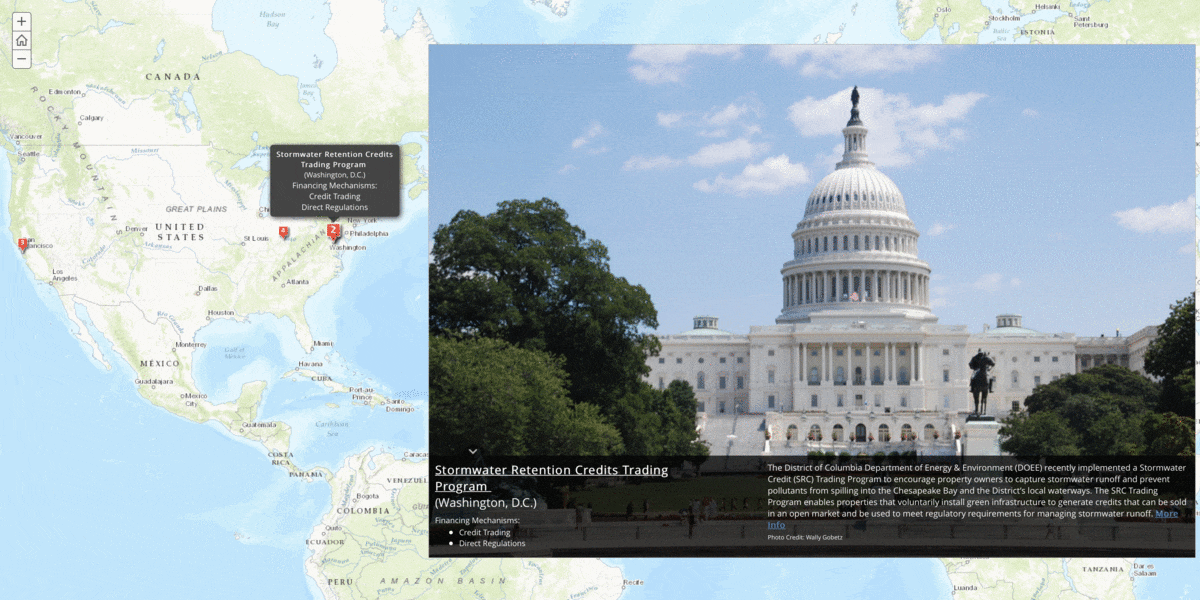April 18, 2017 | Water in the West | News
Last month, the American Society of Civil Engineers gave the nation’s infrastructure a near failing grade and estimated that the country will need to spend $4.59 trillion by 2025 to bring its infrastructure back up to even a B- level. Water infrastructure is in particular need of renewed investment due to the combined pressures of population growth, urbanization and impacts from climate change.
The problem is finding the money to carry out these critical but expensive projects that include innovative distributed water systems. Now a team of researchers at Stanford has created a “Living Map” of innovative ways to finance water projects in the United States that they hope will help regions finance upgrades.
“We need a new playbook that embraces a holistic view of our water system and offers new ideas and solutions for our aging infrastructure,” said Newsha Ajami, director of urban water policy at Stanford’s Water in the West program and leader of the map project. “Integrating distributed water projects such as green infrastructure, wastewater recycling and storm- and graywater reuse into our current infrastructure network can enhance the flexibility and reliability of our water systems.”
Federal and state funding for these types of projects is limited, and local entities are usually too cash-strapped to meet current maintenance costs, let alone the costs involved with new projects. Private funding can also be difficult to acquire given the small return on investment and perceived risks of many of these projects.
The Living Map shows case studies of successful innovative water financing efforts around the country designed to be implemented at various scales. The case studies feature a wide variety of mechanisms; for example, some are market-based systems like credit and permit trading used to implement “green infrastructure” projects built to manage stormwater runoff.
Case studies
One example looks at the Stormwater Retention Credit Trading Program in Washington, D.C. The program enables property owners who install green infrastructure to generate credits that can be bought and sold on an open market and used to meet regulatory requirements. This ultimately helps capture stormwater and prevent pollutants from entering the Chesapeake Bay and local waterways.
The map builds on work in a 2016 Water in the West report that created a framework for water project financing with lessons from the electricity sector.
“We wanted to show that not only are these options available and possible in the electricity sector as they were laid out in our 2016 innovative financing report, but that various water utilities are already employing them,” said Ajami.
The map will be updated as more case studies of new and different ways of looking at water infrastructure needs come to light, hence the name “Living Map.” Ajami encourages stakeholders, researchers and decision-makers throughout the United States working on inventive water financing efforts to partner with her and the team to add projects to the map.
“The fact that it’s hard to access funding for distributed and unconventional water projects is not an excuse not to act,” Ajami said. “The Living Map gives a visual understanding of what is happening throughout the country and how grants, rebates, fees and other innovative governance structures are used to fund alternative water projects. It supports the view that there is not a one-size fits all approach to funding infrastructure and we as a community need a portfolio of financing tools and options for the water sector.”
Newsha Ajami also co-leads the Urban Water Systems & Institutions Thrust at the NSF-ReNUWIt Engineering Research Center, and is a member of the Bay Area Regional Water Quality Control Board.
Media Contacts:
Newsha Ajami, Water in the West at Stanford University, NSF-ReNUWIt: newsha@stanford.edu, (650) 724-8162
Devon Ryan, Stanford Woods Institute for the Environment: devonr@stanford.edu, (650) 497-0444



![[Woods Logo]](/sites/default/files/logos/footer-logo-woods.png)
![[Bill Lane Center Logo]](/sites/default/files/logos/footer-logo-billlane.png)